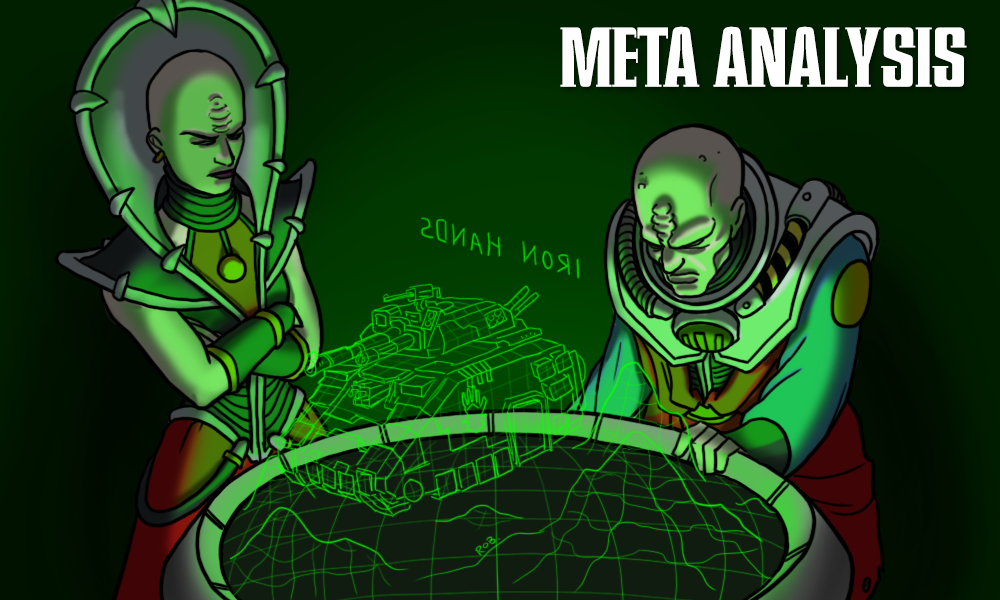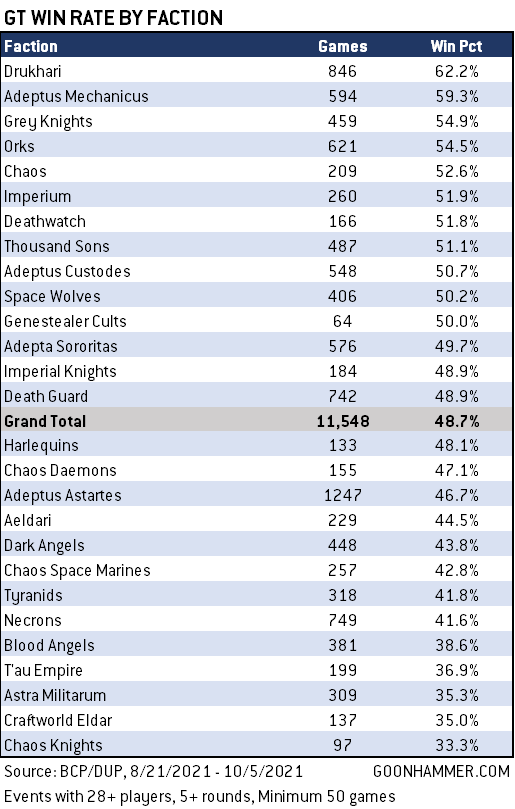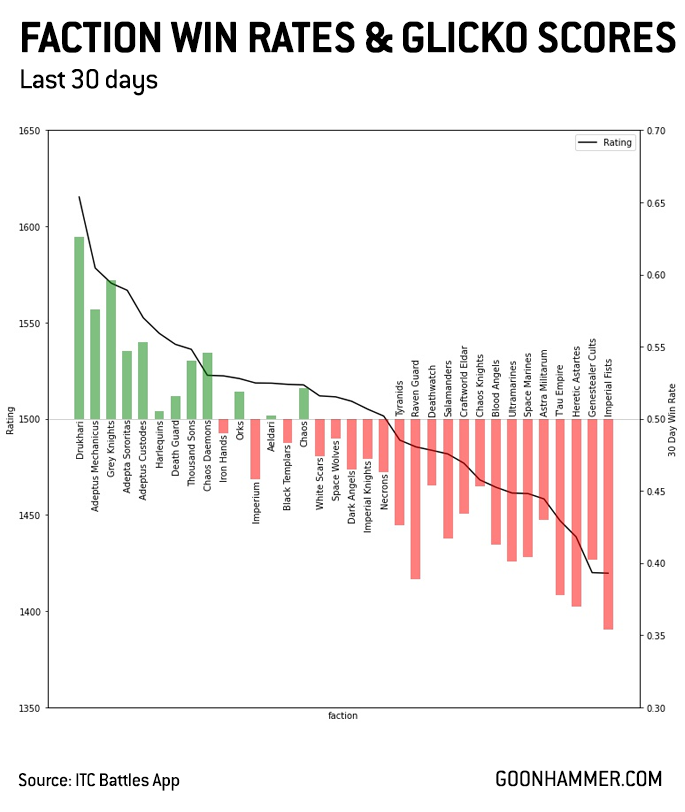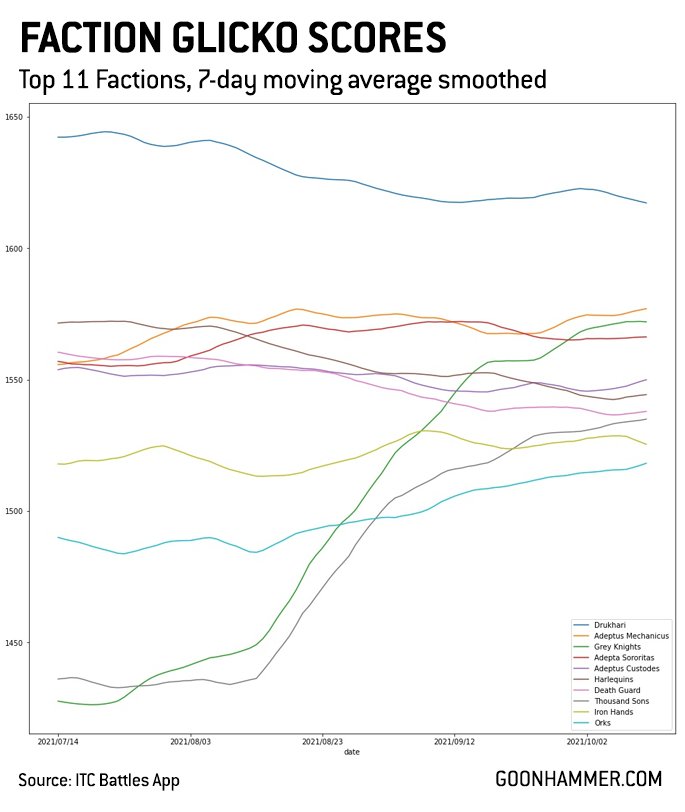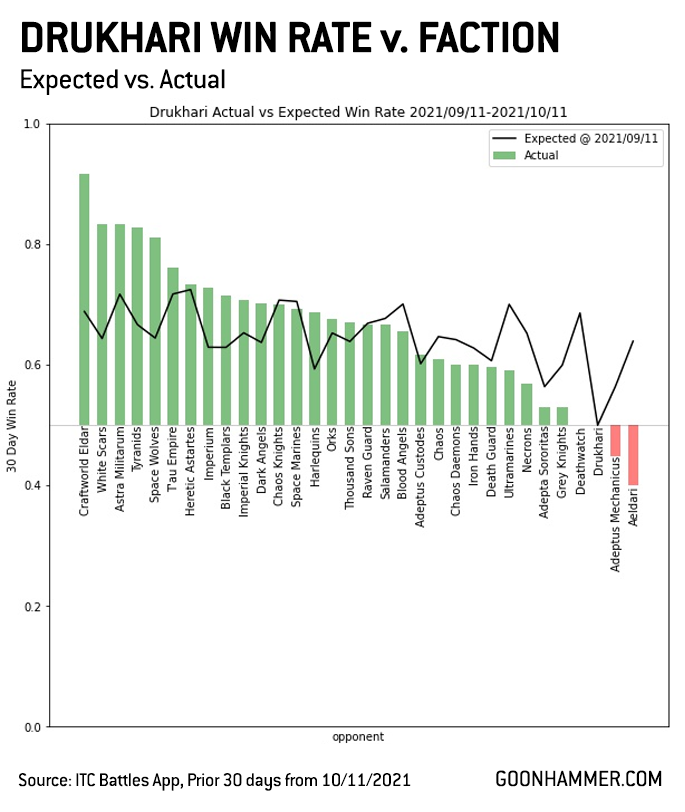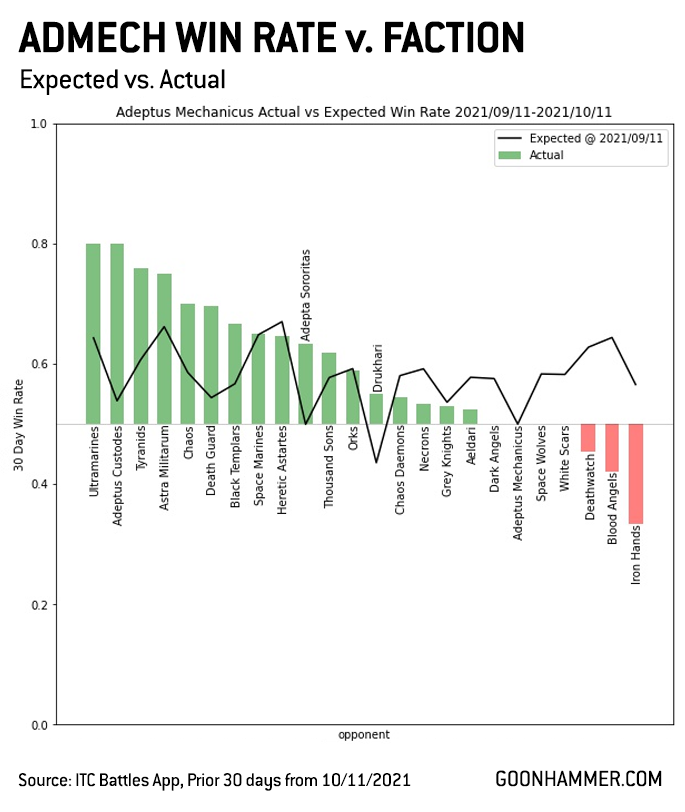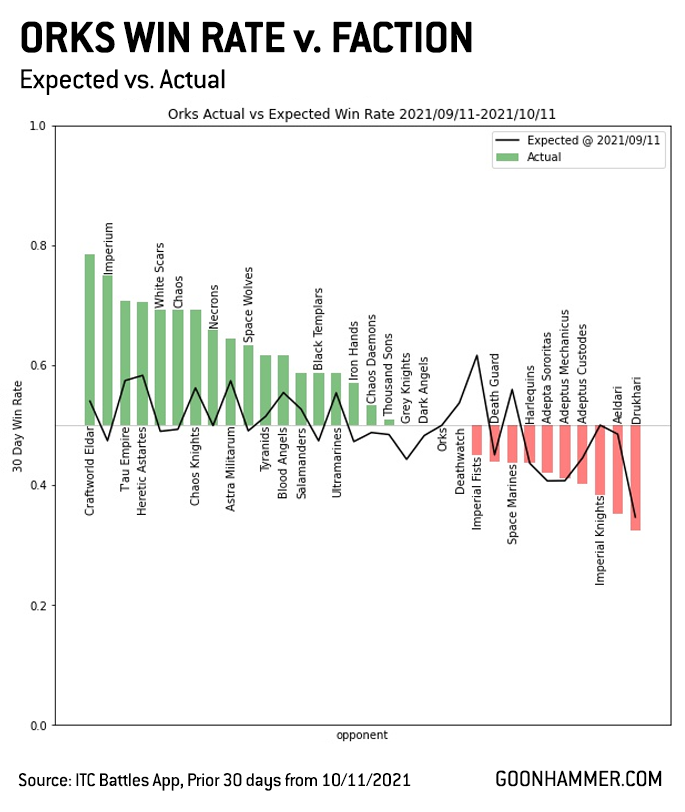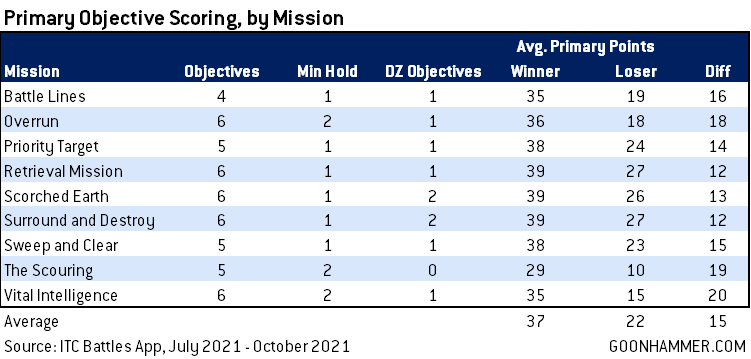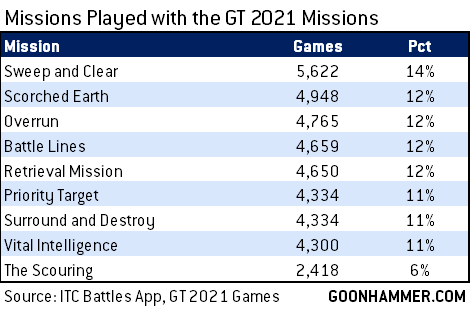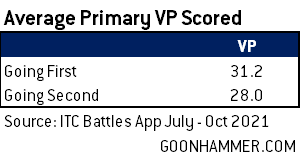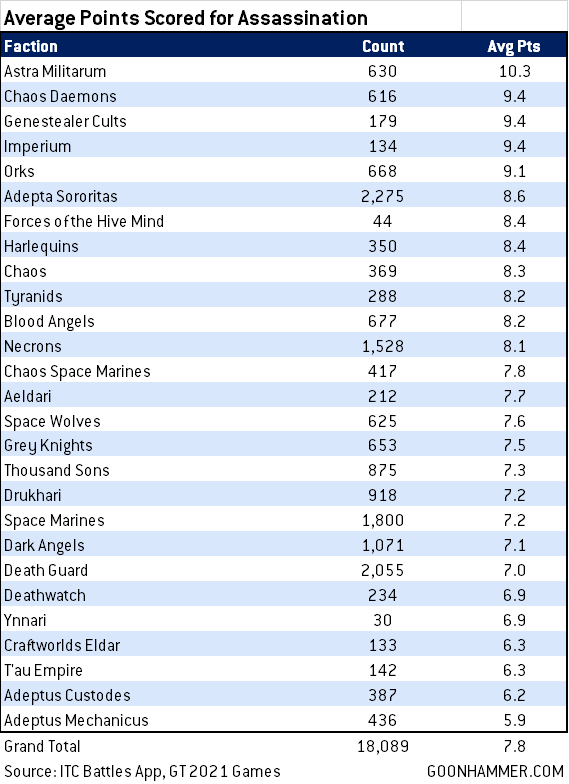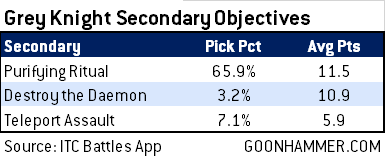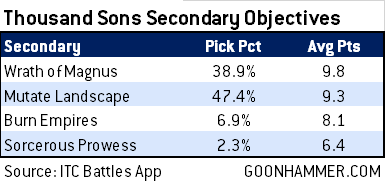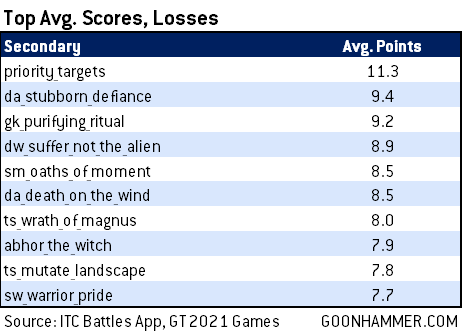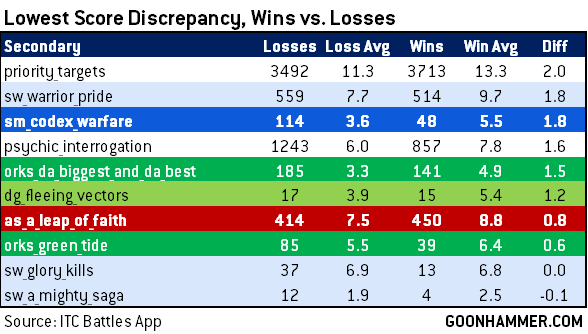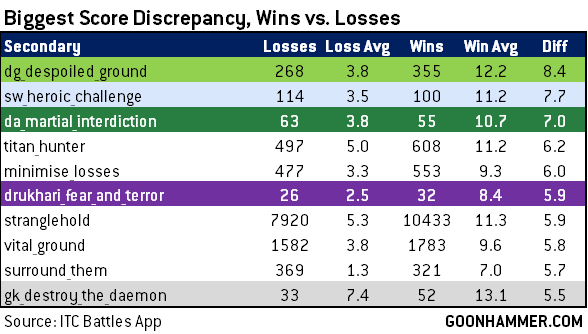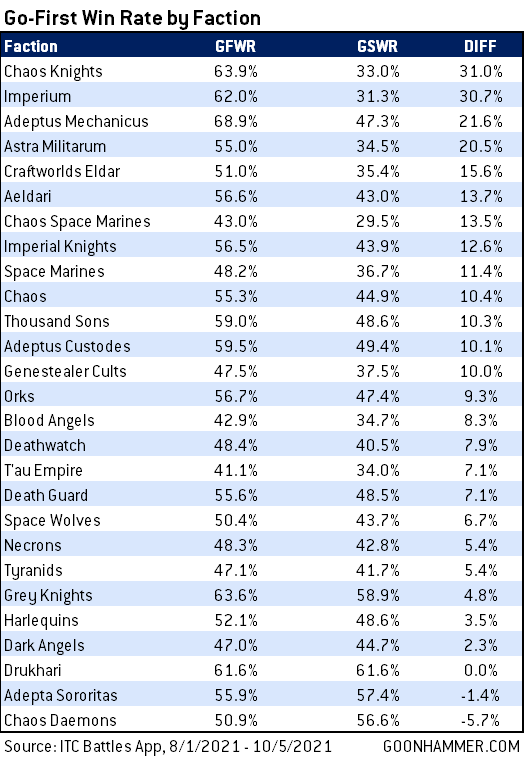Welcome back, dear reader! We have returned following a massive list of new tournaments, energized with ALL SORTS OF NEW DATA, mostly concerning the newer faction releases – Orks, Grey Knights, and Thousand Sons. This month we’ll be spending some time looking at how those books have fared and look at whether they’ve shaken up the meta or merely convoluted the list of “also-rans.”
Methodology
Thanks to the wonderful efforts of tournament organizers and app developers around the world, we have access to what is essentially every meaningful piece of data around competitive games of 40k. The data in this month’s study comes from:
- Best Coast Pairings/Down Under Pairings apps, the premier way to run, manage, and track results for tournaments
- The ITC Battles App, a brilliant app for tracking games both in and out of tournaments and a great source of casual game data worldwide
We also frequently check the wonderful site 40kstats.com for some results data and to look at lists. It’s as large and complete a dataset as you could ever ask for for 40k. This month’s data specifically comes from the period ending on October 5th, 2021 in Best Coast Pairings and the period ending on October 11th, 2021 for ITC Battles App. The data contains tens of thousands of games worth of data from the ITC Battles app and Best Coast Pairings.
On certain occasions we’ll reference “statistical significance.” We often do significance testing between two population means during these analyses, most often with differences in go-first win rates between two samples. When we conduct these, they’re conducted on a 95% confidence interval (p=0.05) unless otherwise specified.
What We’re Covering This Month
We’ve got three books to talk about – Grey Knights, Orks, and Thousand Sons have all been out long enough and had their new releases hit the market and we can now start looking at how their win rates and adoption rates have changed. We’ve also got some digging to do around faction secondaries. And finally, it may behoove us to discuss go first win rates again, though honestly we’re pretty sick about talking about them – they haven’t shifted since January and it’s a bit exhausting having to re-address them every time some new event throws another small sample of games into the mix and someone declares the first turn advantage finally dead thanks to terrain/missions/faction balance/luck. Anyways, this month we’ll be covering:
- Faction win rates and results from the last month
- Grey Knights, Orks, Thousand Sons, and Adepta Sororitas
- Drukhari and Mechanicus dominance
- Faction secondary objectives
- Go First Win Rates again, I guess
The Results over the last month
With another month of results in, we can look at how faction Glicko scores and win rates have changed, both in the ITC Battle App and BCP. Mostly we’re interested in how the game’s top two factions have fared, and how the newcomers are doing.
First, let’s start with the GT data. We trim this back to just look at games played at GT events; that is, events with 28+ players and 5+ rounds of games played. (Note: The overall win rate is less than 50% because ties occur)
Genestealer Cults managed to small sample size their way into a 50% win rate at GTs over the last two months – for another picture of the faction landscape, here’s what win rates and Glicko scores look like using ITC Battles App data.
In a development that will surprise no one who’s been paying attention to our weekly “Competitive Innovations” column, Drukhari and the Adeptus Mechanicus continue to dominate results, with a 62.2% and 59.3% win rate, respectively. In addition to posting the highest overall win rates, they’re also dominating at the highest levels.
This can be seen in the faction Glicko2 scores. Like elo, these scores reward a faction when players win games against other factions with a high score and penalize them for losing to factions with low scores, ensuring that the top scores will indicate factions that aren’t just beating up on weaker factions. You can see the trends for our top 11 factions by Glicko score, below.
Drukhari and Admech remain on top, but we have two new challengers entering the mix: Grey Knights, whose meteoric rise has them vying for the #3 spot, and Thousand Sons, who have more quietly risen to compete around the same level as Death Guard. The new books have given new life to those factions, with Thousand Sons eating a significant portion of the Death Guard player base as it pulls more chaos players away, and Grey Knights eating a chunk out of the Admech contingent.
So we’ve got two clear top factions and then everyone else. Let’s start with the 500-pound gorillas in the room, then address the new factions and where they fit into this meta.
Who’s Better: AdMech or Drukhari?
This is a tough question, in part because the stats can be misleading here – Drukhari still tend to command a higher overall win rate and Glicko score than the Adeptus Mechanicus, and have more podium appearances at GT events over the last two months, but they’ve also been losing to Admech on top tables in recent events. Head-to-head, our data suggests that Admech beat Drukhari around 53-55% of the time depending on the dataset, giving them a slight edge in competitive head-to-head play and being one of the only real bad matchups the Drukhari face (the other is mixed Aeldari armies that also include Drukhari and are tooled out to beat Drukhari). So how is it that Drukhari end up with higher win rates overall but may be worse than the Adeptus Mechanicus?
A quick note on these charts: In each win rate v faction chart, we’re displaying both the faction win rate in the ITC Battles app (the bars) and the “predicted” win rate based on Glicko2 scores that we expected to see for the faction vs faction matchup back in September, using the prior two months of data (the line). Where a bar is above the line, a faction outperformed its expectation. Where the bar is under, it underperformed.
The answer is likely in the mid-tables. Bad Drukhari lists are likely much harder to construct than bad Admech lists, and the former tend to be much stronger, meaning that Drukhari win rates at middle tables will likely be much higher, bolstering the faction’s win rates.
As such, Admech are just less likely to dumpster every faction across the board in the same way Drukhari are – and they still make up a smaller portion of the field – and may have unfavorable matchups against some marine armies when they aren’t running their optimal configurations.
For some additional context on this, I asked some of our top competitive contributors who they felt was better and why.
Richard Siegler: Drukhari are significantly easier to play and win with for the average player. Admech have the best army wide abilities in the game, Drukhari has insane speed and plays msu trading insanely well, but Admech are more well rounded and can do damage in every phase.
James “Boon” Kelling: Honestly, outside of select builds, I think Drukhari are overall more busted, but the current ad mech builds that we saw at LGT, NOLA, etc. are potentially the most broken thing in the game so…
Michael Pestilens: AdMech. Drukhari are just innately busted in 9th edition missions with a ton of fast units that are either hyper killy or ObSec with shenanigans available. AdMech are BUSTED if built to be busted, but the average AdMech list I see is much worse
Falcon: They are both busted in their own way. Drukhari podium more easily and it is harder for Admech lists to pivot after changes but good Admech lists are absolutely brutal and unforgiving.
James “One_Wing” Grover: The nature of the drukhari book is that it’s almost impossible to put together something that looks like an army that’s anything less than great, whereas AdMech do have weaker choices, and their best lists are eye-poppingly insane dollar-price wise.
Falcon: Because Kataphrons exist.
Our top player set came down almost exclusively in favor of Admech, but it’s not a particularly close competition when looking at other factions in the game. Since August, Drukhari have won one third (33%) of GT events run, and Admech have won another 19%. Collectively, these two factions account for about 20% of top 4 finishes over that time period, and only Sisters (5) and Orks (6) have recorded more than two event wins during that same time period. The consistency among these factions at the top levels of play is staggering and while only Genestealer Cults, T’au, and Chaos Knights failed to notch any top 4s over the last two and a half months, it’s not the case that any faction can compete – at least not so long as your definition of “compete” includes “actually being able to win.”
Grey Knights
Likely the best of the post-AdMech codexes, Grey Knights don’t have a lot of builds, but the ones they do have can hit like a sledgehammer. They do well against every faction except Drukhari, Mechanicus, and Sisters of Battle, and continue to trend upwards – they just racked up some more impressive finishes this past weekend to punctuate this rise. Where Grey Knights perform exceptionally well is against Harlequins, who just roll over completely against an onslaught of mortal wounds bypassing their invulnerable saves and to hit modifiers.
Some of this success is also fueled by Grey Knights having the game’s single best codex secondary objective: Purifying Ritual, which has replaced Herd the Prey as the most valuable secondary in the game. Purifying Ritual is worth an average of more than 11.5 points per game, and shows up in 66% of Grey Knights games. We’ll talk more about this secondary later on but it’s a big help for a faction, the likes of which are only rivalled by the Drukhari Herd the Prey secondary (11.2 average points per game).
It also helps that Grey Knights are very mobile and have decent – if still negative – matchups against Drukhari and Admech. Interceptors can murder almost anything in the Drukhari arsenal, and that prevents the faction from spreading out as much as it would like. As they continue to put up top results, better players may flip their negative Sisters and Drukhari match-ups, and some of our top players think they’ll end up being the 2nd best faction before too long.
Thousand Sons
The other new psychic kids on the block, Thousand Sons have seen some initial success, clocking one GT win and six top 4 appearances since the start of August, but their overall performance lags significantly behind Grey Knights, a faction that many players expected would be weaker when the books first released. While the Thousand Sons’ numbers are respectable, there are three easy answers to why the Thousand Sons haven’t seen the same success:
- Thousand Sons Don’t have the Purifying Ritual secondary. While their secondary objectives are good, Mutate Landscape and Wrath of Magnus only average a 9-10 points per game, and the latter is completely unusable against opponents without psykers, such as Drukhari and Admech, and Drukhari can be pretty good at stopping Mutate Landscape.
- Thousand Sons have much worse matchups against Drukhari and Admech, the game’s top two factions. The sons of Magnus are just much more limited in the turn 1 pressure they can apply compared to the Grey Knights, and individually none of their datasheets are quite as good as Interceptors.
- Thousand Sons have a very bad matchup against Grey Knights, the game’s other psychic faction. Both of their more commonly used Codex secondaries are terrible against Grey Knights, and Grey Knights specialize in stopping psychic powers.
All of this makes Thousand Sons an interesting faction that can clean up against weaker factions, but keeps it on the outside looking in against the top competitors.
Orks
This brings us to Orks. The faction of green football hooligans is still developing – in part because the Kill Rig only released two weeks ago – but they’ve been making an honest attempt to crack the top 3 since their book’s release, notching 6 GT wins and 13 top 4 spots since August.
Compared to the other factions in our top list, Orks have more bad matchups, and more ways to build bad lists. They tend to underperform against Knights, Custodes, and Death Guard, three of the gatekeeper factions that haunt the upper tables late but fail to break through these days, hurting their chances of breaking through themselves. They’re also just completely outmatched against Mechanicus Stratoraptors and can have a very rough matchup against Grey Knights, particularly on tables with dense terrain. This ultimately means that Orks have a lower Glicko score than any other “top” faction in the game, coming in at 11th despite impressive tournament finish numbers.
Here’s the thing about Orks, though: They’re also the most likely of the game’s top factions to get better from here. The faction’s performance should get better as the Kill Rig becomes a regular fixture of lists and we haven’t received any details yet about Octarius book 2, but it’s a safe bet it’ll feature something for Orks, and having more options and builds can only help (and worst-case, bad new rules aren’t likely to hurt, since they’ll be add-ons if they’re a supplement or army of renown). Every supplement released in campaign books so far has had a competitive impact, but the armies of renown have been much more hit-and-miss. It remains to be seen what we’ll get here.
Adepta Sororitas
I wasn’t initially going to talk about Sisters, but then it seemed like a no-brainer to include them as the remaining of the game’s “Tier 2” factions (along with Grey Knights and Orks). The Adepta Sororitas match up exceedingly well against space marines of most flavors and also have good matchups against the psychic upstarts, Grey Knights and Thousand Sons. Overall Sisters look great on Glicko because their losses come against top factions, but their win rates at GT events show that the faction is much less consistent, averaging just under a 50% win rate. What keeps them from finishing at the top levels are negative matchups against Drukhari and a horrendous matchup against the Adeptus Mechanicus, two factions they need to beat to claim the top spot.
Looking Ahead
So what’s coming down the pipeline for us to look at next time here? Well, Black Templars are likely to make a decent splash – the book adds some strong mechanics for marines and likely positions them as a contender. Tyranids also have some interesting new options and more indirect fire choices that may catapult them from the trash heap to something more respectable. Astra Militarum also have some interesting choices, but it’s less clear whether those are enough to make a difference for the faction.
Also worth looking at in a future article is “Chaos,” where armies with Be’lakor have shown some power, though separating these out in our datasets is a little bit more difficult. Current list analysis shows that Be’lakor lists are hovering around a 54% win rate. And quietly creeping up in the mix are Deathwatch and Iron Hands, each of which have put up decent results fairly quietly over the last two months and may continue to push upward.
Missions and Scoring
Before we dive into secondary objectives, it might be a good idea to come back and review primary objectives and missions, and do a quick discussion about primary scoring.
On average, players score a little more than 29 points on primary objectives per game, with an average of 37 points for winning players and 22 for losing players, a 15-point margin. This varies significantly by mission, however:
- Domination (Hold two/Hold three) missions create more blowouts. These missions average a much higher discrepancy on primary points between the winner and loser – 19 points, compared to only 13 for Take-and-Hold missions. This is mostly because it’s much more difficult to turn off a player’s primary scoring on these missions, save for Battle Lines, where having only 4 objectives means that holding two is much easier to prevent (though scoring “Hold More” is likewise more difficult).
- The Scouring is the lowest-scoring mission and it’s not close. A combination of 5 objectives and Domination as the primary means that games of the Scouring tend to both be lopsided – the second-highest scoring differential – and also the lowest scoring, with losers averaging only 10 VP and winners averaging 29.
That second point is likely what leads players to avoid the Scouring – it’s by far the least-played mission in the GT 2021 Missions pack, and we might recommend GW do away with that particular mission in 2022 if they’re looking to make some adjustments. The favorite? Sweep and Clear.
In the past we’ve looked at primary scoring differential based on first turn. Historically we observed a difference of about 2.6 VP, which seemed to decrease a bit after the January 2021 FAQ moved player 2 scoring to the end of the last battle round. Unfortunately, that discrepancy seems to be back on the rise.
This 3.2-point discrepancy may be due to a sharp increase in the number of armies that are able to take their opponent off the table on turn 1, or just leave them significantly depleted, leaving them with lower primary scoring potential. Admech and Orks are particularly adept at this. More on first-turn win rates later.
Secondary Objectives
We’ve done analysis on secondary objectives before, but with a whole new set having been recently added to the game, it’s time to revisit them. Let’s start by level-setting with the existing secondary list:
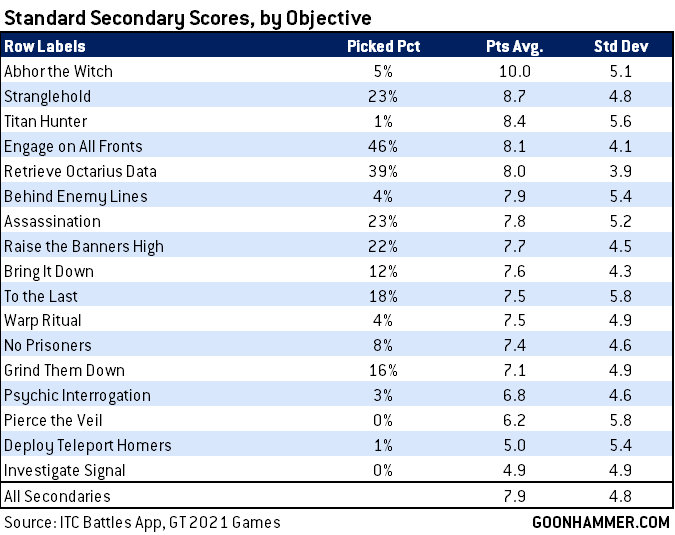 Since the change over to the GT 2021 Missions pack, the value of secondary objectives has largely improved – the average for the rulebook secondaries has gone up, from 7.3 points in December 2020 to 7.9 points now. This despite the fact that some secondaries became notably lower-scoring (specifically, Bring it Down and Abhor the Witch). Retrieve Octarius data is one of the most popular picks from the “new” secondary objectives introduced in the 2021 missions pack and while it’s only average from a scoring standpoint and can’t hit 15, it’s also got the least variance of any measured secondary save Priority Targets (more on that in a bit). The result is that it’s not hitting 15 points but it’s very reliable for scoring 8.
Since the change over to the GT 2021 Missions pack, the value of secondary objectives has largely improved – the average for the rulebook secondaries has gone up, from 7.3 points in December 2020 to 7.9 points now. This despite the fact that some secondaries became notably lower-scoring (specifically, Bring it Down and Abhor the Witch). Retrieve Octarius data is one of the most popular picks from the “new” secondary objectives introduced in the 2021 missions pack and while it’s only average from a scoring standpoint and can’t hit 15, it’s also got the least variance of any measured secondary save Priority Targets (more on that in a bit). The result is that it’s not hitting 15 points but it’s very reliable for scoring 8.
Abhor remains one of the most valuable secondaries, but only when you can actually take it – though with Thousand Sons and Grey Knights out and about, its value has once again increase significantly. Grey Knights in particular give up more points than any other faction to Abhor, on average – 11.5.
On average, players win about 46% of their games against Grey Knights if they take Abhor the Witch, and tend to average 41% when they don’t, a significant swing.
Assassination is another interesting secondary that also has stark list-building impacts. Players tend to score the most points on average when they take it against Imperial Guard, where a mix of tank commanders and softer, easy-to-kill characters make it a choice secondary. Daemons Also suffer against it, where they rely on multiple large psykers that also give up points for Abhor the Witch, and so it’s not a huge surprise that Daemons play against the secondary more often than any other faction.
The Adepta Sororitas are a close second, seeing Assassination picked by opponents in about 14.2% of their games, and they give up an average of 8.6 points to opponents that pick it. Death Guard are another high pick here – their Foetid Virion often give opponents max scoring possibilities – but the toughness of their characters and the presence of bodyguard units (Deathshrouds) make it more difficult to score and so despite getting picked more than 10% of the time, players only average 7 VP from Assassination against Death Guard, suggesting it’s being picked far too often.
Then we have the Mission Secondaries. Here we have Priority Targets and… everything else. Of the remaining secondaries, Direct Assault is a clear stand-out, being scorable at the end of your turn and averaging 9.9 points per game when taken. Data Intercept cand Strategic Scan both average more than 7 points, making them OK picks. And then after that are the rest, and of these Surround Them, Overrun, and Raze are clearly just awful and no one is picking them.
The Faction Secondaries
Now let’s talk about the faction secondaries. Every new Codex comes with new secondary objectives unique to that book’s faction and in terms of power level, these range from “absolutely awful” to “game-breakingly good.” Three new codexes means three new secondaries; how do these stack up?
Grey Knights
Grey Knights have the strongest new secondary, and it’s the strongest faction secondary in the game, beating out Herd the Prey from Codex: Drukhari. Grey Knights players pick Purifying Ritual in two thirds of their games and score 11.5 points off it, on average. That pretty much offsets the disadvantage they give up for Abhor the Witch (11.8, see above), and goes a long way toward making the faction competitive.
Thousand Sons
The new Thousand Sons secondaries are good – they’re both well above the 7.9-mark for universal secondaries – but neither appears to be so good as to be broken. For one, Wrath of Magnus, while good, requires your opponent have psykers. And against armies that have lots of psykers – particularly Grey Knights – it’s not great. Thousand Sons average only 5.6 points per game with Wrath of Magnus against Grey Knights, and only 6.6 points in the mirror. In matchups where Wrath of Magnus isn’t available, Mutate Landscape makes a fine alternative, though Warp Ritual also scores above average for Thousand Sons.
Orks
Orks don’t really benefit much from their secondaries. None seem to give the faction above-average scoring, and only Stomp Em Good sees any real play.
Drukhari and Admech
Let’s talk about these two factions again. For Drukhari, there’s basically only Herd the Prey, which averages an astonishing 11.3 points per game. Removing this secondary certainly would hurt the faction, though how much isn’t clear – Drukhari generally do well scoring when it comes to Battlefield Supremacy, averaging more than 10 points for Stranglehold and Behind Enemy Lines.
For the Mechanicus it’s a cloudier picture; their strongest non-mission secondary is Stranglehold (9.5) and they’re better at scoring Grind Them Down than Drukhari, but the Codex secondaries are more situational, being picked less often and generating fewer average points.
Winning and Losing
We’ve mostly talked about secondary objectives in the context of averages across all games; how does this change if we split wins and losses? Are some secondaries better for scoring in lost causes? Are some secondaries “win more,” e.g. they’ll only be good if I’m already winning the game some other way?
The game’s best secondaries in a loss are Priority Targets, Abhor the Witch, and a lot of faction secondaries. The Stand-outs here are the Dark Angels’ Stubborn Defiance and the Grey Knights’ Purifying Ritual, which is just incredibly easy to score. If we look at the difference between win and loss scores, we can get a better picture for which ones swing heavily in either direction.
The secondaries that have the smallest difference between wins and losses are Priority Targets (seriously, always take this), Space Wolves’ Warrior Pride, and the Space Marines’ Codex Warfare. Note that, with the exception of Priority Targets, most of these are not good secondaries and are rarely taken.
On the other side of the equation we have Despoiled Ground for the Death Guard, the most win-more secondary in the game. This objective is worth an average of 12 points in a win and fewer than 4 in a loss.
Let’s Talk About First Turn and Win Rates
I mentioned first turn win rates earlier. They’ve gotten a little worse since January, going up to 54.1% with a larger primary VP discrepancy than we’d previously measured. This is likely as a result of top armies being more deadly than ever when it comes to executing turn 1 strikes. This is borne out by looking at Go-First Win Rates by faction.
There’s a clear distinguishing factor here – some factions compete generally and thrive when going first – Adeptus Mechanicus and Grey Knights among them, each averaging more than 63% win rates when going first – and some just depend on it to get wins at all, like in the case of Chaos Knights and Astra Militarum armies, who only win around one third of games going second. Interestingly – and counter to our prior analyses – there are now two factions that appear to regularly benefit from going second: Adepta Sororitas post a slightly higher win rate going second, suggesting they benefit from an opponent moving into their kill range on turn 1, and Chaos Daemons, who have almost now shooting as an army.
These effects seem to be exacerbated in tournaments with record matching as players of more equal skill levels are paired up in later rounds, reducing the ability for players to overcome the disadvantage of going second by relying on the discrepancy in player skill levels.
To that end, the recent Games Workshop Open Events in New Orleans and Orlando have made claims that these problems are solved with terrain; in our prior analysis that did not appear to be the case, and the event itself represented a small sample size. With New Orleans the numbers appear to be better – the data in BCP suggests an overall go-first win rate of 51.9% at New Orleans – though again, this is a small sample size and the difference isn’t statistically significant from the 54.1% we’ve measured over the 11,947 games recorded in the ITC Battles App since August.
A note on the data: Best Coast Pairings does not have first turn records for every game at the Games Workshop events. I assure you that I’m just as frustrated as you are that some events are hand recorded or do not include this data, particularly since GW’s published results would indicate that these are overwhelmingly games where the player who went second won, and the majority of these unrecorded games are in rounds 7 and 8, where Go-First Win Rates normally skyrocket, as was the case with Orlando. That would indeed be good data to have.
The other thing to note is that these Games Workshop events are not the lowest go-first win rates we’ve seen. Looking at the data we have from events run since January, we can see several events with lower go-first win rates, and many more with higher rates:
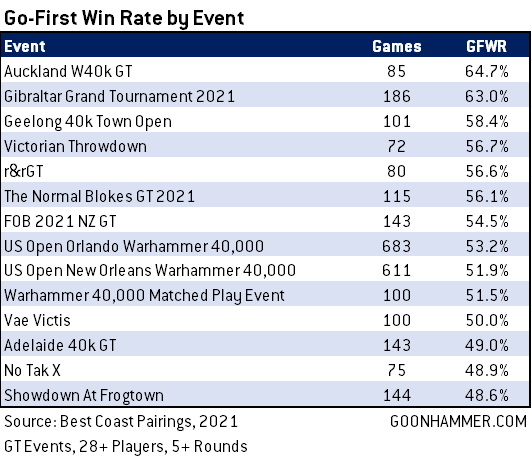 On the low end, we’ve seen five events with lower go-first win rates than Games Workshop’s recent Majors, though none with nearly as many games. We’d initially hoped to dig deeper into the potential impacts of terrain on Go-First Win Rate here, particularly given some of the feedback we’d heard around the London Grand Tournament terrain. Unfortunately, First turn data for the LGT wasn’t available in BCP so we can’t confirm whether the terrain had an impact on first turn. Additionally, we’ve heard that LGT is adding additional “Large L” obscuring terrain pieces for their next super major event, so it will be interesting to see how player perceptions change there.
On the low end, we’ve seen five events with lower go-first win rates than Games Workshop’s recent Majors, though none with nearly as many games. We’d initially hoped to dig deeper into the potential impacts of terrain on Go-First Win Rate here, particularly given some of the feedback we’d heard around the London Grand Tournament terrain. Unfortunately, First turn data for the LGT wasn’t available in BCP so we can’t confirm whether the terrain had an impact on first turn. Additionally, we’ve heard that LGT is adding additional “Large L” obscuring terrain pieces for their next super major event, so it will be interesting to see how player perceptions change there.
The interesting thing about this is that the best events with regard to go-first win rate still only manage to stay within what we’d consider an “acceptable” margin for the player going first; that is, in an ideal world the go-first win rate of games of 40k would hover between 47.5% and 52.5%. Were the game actually more equitably balanced, we might expect to see events with lower go-first win rates, dropping into the low 40s. Instead, the high upper end suggests that it takes a lot of work, thought, and planning in order to create a terrain layout that gets you within the high end of an acceptable go-first win rate.
GW’s efforts here are commendable; the terrain at the US Open events appears to have helped create significant improvements in Go-First Win Rate. We’d only suggest that they didn’t have to make it this difficult to begin with.
Next Time: Black Templars, Probably
That wraps up our October look at the 40k Meta. There’s a lot to consider, and over the next month we’ll be watching intently to see how Grey Knights impact the meta. By the next time we do this Black Templars will have come out and had time to play some games, so we’ll take a look at them in about 6 weeks. Until then, if you have any questions or feedback, email us at contact@goonhammer.com.
